Symphony Story Times: What’s Music Got To Do With It?
Many orchestras currently offer, or collaborate in, musical story times for the younger audiences in their communities. Typically at these programs, young children listen to a narration of a popular children’s book while being accompanied by a live, musical performance by a solo instrumentalist or larger ensemble. The addition of a live musical performance to a narrated story time is exciting and inspiring for these young children. For some, this may be their first time seeing the instrument or hearing it played live. Others may find that the story telling experience is more vibrant and enjoyable with the addition of a musical performance.
Usually, the specific story content will drive the music selection or instrumentation. For example, a story about a trumpet will be accompanied by a trumpet player. Other programs might use a type of “Peter and the Wolf” model, where the characters in the story are represented by different melodies or instruments. Moreover, the music is often used to enhance the overall emotion within, or content of the story. A scene containing action and excitement can be imitated by the fast-moving, rhythmically accented performance by the musician. While these musical story times offer fun and added excitement for the young children’s music and literature experience, they are missing out on an added learning opportunity.
Imagine a musical story time program that also serves equally to aid in the development of a child’s musical perception and early literacy skills. Besides the added interest and excitement that comes with a story time musical performance, the specific program design also serves to build emerging literacy skills such as phonemic awareness and phonological memory, skills that are crucial to the developing, early readers.
In the New Bedford Symphony Orchestra’s musical story time program entitled Symphony Tales, the music is specifically composed to imitate the prosodic elements of the story’s text. By prosody, we refer to the variations in tone, phrasing and inflection that occur when speaking. In the Symphony Tales program, the music imitates these speech variations by matching the same stress patterns, pitch, contour, rhythm, phrasing and tempo as the text of the story.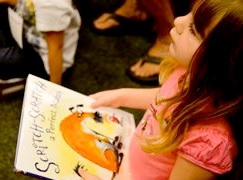
This new concept of linking prosody in text and music is based on recent findings in cognitive psychology that show that music and language have a shared neural perception system and have strong similarities in syntax processing (McMullen, Saffran, 2004). Thus, music perception skills have been shown to strongly contribute to the development of linguistic skills such as phonemic awareness and phonological memory (Bolduc, 2008). This article will take a closer look at research into the relationship between music perception skills and early literacy to offer a makeover for the traditional musical story time. In this new model, the musical story time program serves both music and language development equally. To do so, a music and literacy program must be built on what both music and language truly share.
The question of what music and language share has an interesting scientific history. Most people may assume that music and language have many things in common. Indeed, music and language both unfold in time, and can communicate or depict emotion. They also are perceived as sound or frequency, and both have an aural and written form (McMullen, Saffran, 2004). With so much in common, one might assume that learning in one domain would benefit learning in the other. While music and language have many similarities, the field of neuropsychology has argued for a more modular view of music and language, with both functioning separately in distinct regions in the brain (Patel, Peretz, Tramo, Labreque, 1998).
This modular view was based on the study of brain injury patients who demonstrate a deficiency in music with no affected ability in language and vice versa. Isabelle Peretz, a noted neuropsychologist, studied patients who suffered brain injuries, or brain deficiencies that presented as amusia, a defect in pitch processing and musical memory and recognition, and aphasia, the inability to understand or express speech. In her studies she found that patients suffering from amusia, the deficiency in music, did not exhibit deficiencies in language, and vice versa. Here again, music and language were shown to operate independently (Mithen, 2007). However, there was one aspect that clearly affected both music and language abilities. When a patient lost the ability to speak with inflection or emotion, they also lost affection for music, hearing it only as noise. Other subjects born with amusia who were not able to understand or produce music were unable to identify words when presented with only the speech sounds. These examples demonstrate that the loss of prosody affected both music and language equally.
We can conclude that despite their apparent independence, the separation of the modular music and language systems, however, is not complete, as several modules, such as prosody, appear to be shared between the two systems.” (Mithen 2007, p. 62)
This issue can be further illuminated by new results coming from the field of neuroimaging where music and language have been shown to have both instances of shared processes and other instances of domain specificity or cognitive functions that operate quite independently (Brown, Martinez & Parsons, 2006). This new perspective offers a more complete view of what music and literacy share, and what they do not. We know that some processes involved in the perception or input are shared between music and language, while specific knowledge within each domain is stored separately in distinct brain networks. This explains why Peretz’s brain injury patients lost the access to stored knowledge in either music or language, but the shared perception process including prosody thereby affected both. (McMullen, Saffran, 2004)
“When two domains draw on common brain resources, they do so because these resources provide a particular processing function needed in both domains.” (Pate, 2012, p. 30)
Based on these findings, we may expect to see that increased experience and ability in the discrimination of notes, or musical phrases should transfer to an improved auditory discrimination of phonemes, to syllables, to words, phrases and sentences. Many studies have verified this connection showing that musical perception skills contribute to the development of linguistic skills such as phonemic awareness, phonological memory, and vocabulary development in young children.
In a 2006 study, preschool children participated in a specialized music program that focused on music perception tasks. The researchers found that the children who participated in this program showed increased phonological awareness and vocabulary development (Galicia, Contreras, Gomez & Flores, 2006). Another study in 1997 and 2005 used preschool children to participate in an interdisciplinary music program. They found that the children participating in this program showed enhanced emergent literary abilities such as stronger auditory perception and analytical abilities, and stimulated phonological memory (Bolduc, 2008).
The NBSO’s Symphony Tales program has been designed with the awareness of these shared processing mechanisms between music and language. Moreover, the design makes the overlap even more obvious by overtly connecting the prosodic elements in language to the prosodic elements in music. In this model, the stress patterns, contour, and rhythmic patterns of the children’s storybook text are synchronized to the stress patterns, rhythm, and melodic contour of the music. Following this design, a Symphony Tales performance and the interactive activities that follow, the distinctions between musical prosody and language prosody are merged, with one flowing seamlessly into the other, and each reinforcing the other.
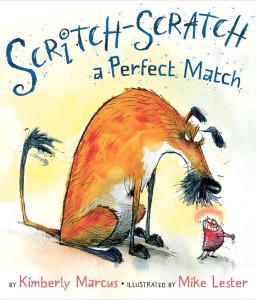 The Symphony Tales program begins with an unaccompanied reading of the children’s book by an adult reader. This past year we were fortunate to have this reader be Kimberly Marcus, the author herself. While the author’s presence is not vital to the program, it certainly added an exciting opportunity for children to meet her and hear her narration, knowing that she had created every word.
The Symphony Tales program begins with an unaccompanied reading of the children’s book by an adult reader. This past year we were fortunate to have this reader be Kimberly Marcus, the author herself. While the author’s presence is not vital to the program, it certainly added an exciting opportunity for children to meet her and hear her narration, knowing that she had created every word.
This initial, unaccompanied reading of the book is important since it provides an opportunity to convey the content or events of the story while showing the book’s illustrations to the children. Children’s expectations for a story time include the chance to see the illustrations as they provide enjoyment and added information to their understanding of the story. While the pictures were shown during the unaccompanied reading of the story with the author, the Symphony Tales performance with narrator and musician purposely omits the pictures from the musical performance. This decision was made based on literature that investigated the affects of visual stimuli or illustrations on children’s auditory perception awareness. In the article Text Talk: Capturing the Benefits of Read-aloud Experiences for Young Children, the author describes how young children will derive meaning first from pictures before the spoken text as they are more accustomed to getting new information about their world through visual means (Beck, McKeown, 2001). In one example, the children listen to a story about Socrates the dog.
In a picture, Socrates is wearing big, bright red glasses. In the beginning of the story, Socrates has a series of unfortunate events, as he is lost, alone, hungry and scared. When the teacher stops after these events and asks, “What can you tell me about Socrates right now?” The children respond, “He needs glasses.” The image of Socrates in his glasses supersede the perception and comprehension of the spoken text. It is not that the children did not listen to the story, but that the information provided from the illustration is more readily available than the comprehension or analysis of the events of the story (Beck, McKeown, 2001).
In the Symphony Tales program, the focus remains on the auditory perception of the spoken text and the prosodic imitation in the musical performance. By eliminating illustrations from the book, the children are more likely to attend better to the auditory aspects of the performance.
After the selection of Kimberly Marcus’ book, Scritch Scratch a Perfect Match, the next step was to compose a piece of music that would imitate the prosodic elements in the text. The composition process for Symphony Tales offered unique challenges to NBSO artistic director Dr. David MacKenzie. Here he describes the process by which he composed the music to accompany Scritch Scratch a Perfect Match.
Part of the challenge in writing the music for Scritch-Scratch was how to utilize the prosodic elements of the text as materials without become too “thematic” with the resulting music. Normally composers are trained to work their materials in such a way that they create longer structures of a unified character – melodies, themes. These themes then both unify the musical work and maintain an independent aspect within it.
Since our goal was to create a piece that aided in the development of literacy in young readers by presenting the story authentically in words that are spoken and “words” that are played, it was important that a melodic structure did not arise that became so unique and independent that it became a “thing” separate from the story.
Because a melody engages so many different elements in the brain of the listener, it can become “sticky,” so to speak. Once you have heard it, you can’t un-hear it. I needed to use the cello as another voice to “speak” the text, without the music taking over, overwhelming the story itself, allowing the story to be the unifying element for both the spoken and “played” words.
So the challenge was how to use the prosodic elements of the text – rhythm, intonation and inflection, emphasis, etc – to create interesting, compelling music that acts as a second “voice” in the performance. Since the text is set in a relatively consistent metrical rhythm, the danger immediately became a certain predictability of pattern that quickly becomes boring. Yet the cello’s “reading” had to remain true to the prosodic elements of the text.
Without resorting to overly thematic qualities, there evolved certain recurring motives that unify the work without become independent themes. And, there is considerable variety in the division of labor, so to speak, between narrator and cellist. Sometimes the cello directly imitates the patterns and inflections of the speaker, sometimes it anticipates them, and sometime it falls into an accompaniment role, providing some element of contrast to build continued interest.
It all seems to work very well; the response from parents, teachers, and the students themselves has been extremely positive. It definitely provided me the most unique challenge of any work I have written.
Following the performance, we engage the children in three activities. First, the cellist begins by introducing herself to the audience. As she introduces herself, she plays a corresponding musical phrase on her cello, matching all prosodic elements in her speech. In other words, her cello speaks along with her. She then goes around the room, asking different children for their name. She and the cello ask, “What’s your name?” The child answers and then the cello improvises an imitation of the sound of his or her name to answer back. The children are delighted to hear the sound of their name performed musically with matching melodic contour and rhythmic stress patterns. After a couple more children take their turn, the cellist slightly adjusts her performance.
Now, she does not verbally speak her question, letting the cello alone ask,“What’s your name?” to the next several children. It is astounding to see how seamlessly this occurs, as children do not notice that she has stopped speaking. The children simply respond to the cello’s musical question by answering back with their name.
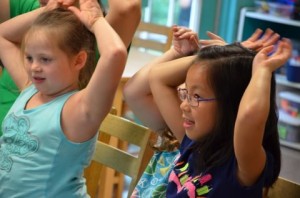 The second activity expands upon this idea. I sit before the children and ask them to recall what happened in the beginning of the story where the pesky flea jumps onto the dog’s hair. I ask them to echo back my words while imitating my hand motions. Breaking the text phrase into segments, they echo back “Flit, flit flapped the flea in the scruffy dog’s hair.” Each stressed syllable is accompanied by a fun hand and arm motion, such as flapping puppy ears moving on stressed syllable of “scruffy dog’s hair.”
The second activity expands upon this idea. I sit before the children and ask them to recall what happened in the beginning of the story where the pesky flea jumps onto the dog’s hair. I ask them to echo back my words while imitating my hand motions. Breaking the text phrase into segments, they echo back “Flit, flit flapped the flea in the scruffy dog’s hair.” Each stressed syllable is accompanied by a fun hand and arm motion, such as flapping puppy ears moving on stressed syllable of “scruffy dog’s hair.”
We practice these text phrases a few times and then the cello takes a turn as the leader. The cello plays back a part of the musical segment of the piece that represents the sentence they just learned. The children must listen to the contour, rhythm, and accent of the musical performance to determine which part of the text phrase the cello is performing. To do this, the children must perceive and discriminate the musical elements to determine the matching prosodic elements of the text. They then echo back the appropriate text phrase with the added motions.

This activity continues with another phrase from the end of the story using the same sequence. The phrase, “Zip, zoom off they ran, with a woof and a wee!” is always the favorite for the children.
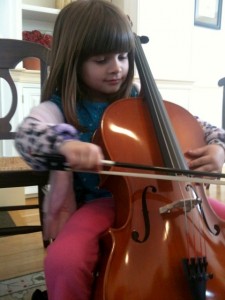
At the end of the program, we bring the children up to play a cello that is sized just for them. They are eager to perform on the instrument, and at the same time they enjoy meeting the author, composer/narrator and cellist.
The program runs approximately forty minutes. With children ranging in ages from four through eight, they remain incredibly focused throughout the program. This is helped in part by the progression from quiet listening and observing during the opening author’s reading and the Symphony Tales performance that follows, to the more interactive activities of the program from the middle to the end.
Symphony Tales performances have been popular in local libraries, preschools and elementary schools. The schools are especially appreciative since many visiting programs are geared toward the older students at the elementary grades.
The Symphony Tales program offers an opportunity to connect the concept of prosody to both music and language in an authentic and meaningful way. In this model, the music and text are equally represented, meeting along common lines. While the use of any music to a children’s story time is an enjoyable and engaging experience for young children, the added benefit of developing their musical and linguistic perception skills gives the Symphony Tales program a perfect storybook ending.

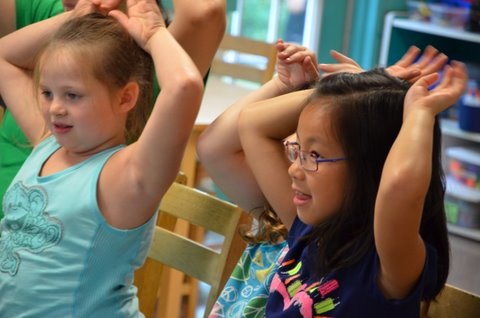
No comments yet.
Add your comment